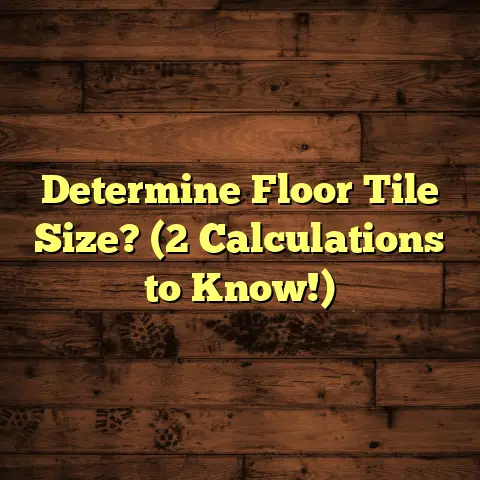Epoxy Flooring for Homes? (The 1 Mistake!)
Ever watched a home renovation show and been blown away by the transformation? I know I have! It’s amazing how new flooring can completely change the look and feel of a space.
Choosing the right flooring is a HUGE decision, and there are so many options out there. One that’s been gaining popularity lately is epoxy flooring. But is it right for your home? And are there any pitfalls to watch out for?
You bet there are!
I’m here to guide you through the ins and outs of epoxy flooring for residential use. We’ll dive into what it is, where it comes from, and why it’s becoming so popular.
Most importantly, I’m going to reveal the one critical mistake homeowners often make when considering epoxy – a mistake that can lead to disappointment and wasted money.
So, grab a coffee, and let’s get started!
1. Understanding Epoxy Flooring
What exactly is epoxy flooring?
In simple terms, it’s a flooring system made up of multiple layers of epoxy resin. This resin is a combination of polymers and hardeners that, when mixed, create a chemical reaction.
This reaction results in a rigid, durable, and seamless surface. Think of it as a super-strong, super-shiny coating that’s applied directly over your existing concrete floor.
But it’s not just one type of epoxy. There are several different kinds available for residential use, each with its own unique properties and applications:
-
Self-Leveling Epoxy: This creates a smooth, even surface, perfect for floors with minor imperfections. It’s like giving your floor a brand-new, flawless foundation.
-
Epoxy Mortar: This is the heavy-duty option, ideal for high-traffic areas or floors that need extra protection against impact and abrasion.
-
Quartz-Filled Epoxy: By adding quartz sand, this type provides a decorative, slip-resistant surface. It’s both beautiful and functional!
-
Epoxy Flake: This involves embedding colored flakes into the epoxy, creating a vibrant, textured look. It’s a great way to add some personality to your floor.
-
Metallic Epoxy: This contains metallic pigments that create a stunning, three-dimensional effect. It’s a truly unique and eye-catching option.
So, why choose epoxy flooring for your home?
Well, the benefits are pretty impressive:
-
Durability: Epoxy floors are incredibly tough and can withstand a lot of wear and tear.
-
Aesthetic Appeal: With so many colors, patterns, and finishes available, you can create a truly custom look.
-
Resistance to Stains and Spills: Epoxy is non-porous, so it’s easy to clean and won’t absorb spills or stains.
-
Seamlessness: No grout lines mean no dirt trapped and a cleaner, more hygienic surface.
-
Cost-Effective: While the initial investment might be higher than some other flooring options, epoxy’s long lifespan and low maintenance can save you money in the long run.
2. A Brief History of Epoxy Flooring
Epoxy flooring wasn’t always a trendy home decor choice. In fact, it started out in a completely different world: the industrial sector.
Back in the 1930s, scientists began experimenting with epoxy resins, discovering their incredible adhesive and protective properties. It wasn’t long before epoxy coatings were being used to protect metal surfaces from corrosion and to create durable floors in factories and warehouses.
These early epoxy floors were all about function, not form. They were designed to withstand heavy machinery, chemical spills, and constant foot traffic.
But as technology advanced, so did epoxy flooring. Manufacturers began developing new formulations that were more versatile and aesthetically pleasing. Colored pigments, decorative flakes, and metallic additives were introduced, opening up a whole new world of design possibilities.
Over time, architects and designers started recognizing the potential of epoxy flooring for residential applications. They saw that it could provide a durable, low-maintenance, and stylish alternative to traditional flooring options like tile, carpet, and hardwood.
And so, epoxy flooring began its journey from the factory floor to the family home.
3. The Popularity Surge
So, why is epoxy flooring suddenly so popular in homes?
I believe there are a few key factors driving this trend:
-
Modern Aesthetics: Epoxy flooring fits perfectly with the clean, minimalist look that’s so popular in contemporary home design. Its seamless, glossy surface creates a sleek and sophisticated feel.
-
Customization Options: With the wide range of colors, patterns, and finishes available, homeowners can create a truly unique and personalized look. Whether you want a subtle, understated floor or a bold, eye-catching statement, epoxy can deliver.
-
Durability and Low Maintenance: Let’s face it, nobody wants to spend hours scrubbing and polishing their floors. Epoxy flooring is incredibly easy to clean and maintain, making it a great choice for busy households.
-
DIY Appeal: While professional installation is always recommended, some homeowners are drawn to the idea of installing epoxy flooring themselves. With the right tools and preparation, it can be a satisfying and cost-effective DIY project.
-
Increased Awareness: Thanks to home renovation shows, social media, and online resources, more people are becoming aware of the benefits of epoxy flooring. As they see the stunning transformations that can be achieved, they’re more likely to consider it for their own homes.
4. Common Applications in Homes
Where can you use epoxy flooring in your home? The possibilities are surprisingly vast!
-
Garages: This is perhaps the most common application. Epoxy flooring can withstand heavy vehicles, oil spills, and dropped tools, keeping your garage looking clean and organized.
-
Basements: Epoxy is moisture-resistant, making it a great choice for basements that are prone to dampness. It can also brighten up a dark and dreary space.
-
Kitchens: Epoxy’s resistance to stains and spills makes it ideal for kitchens. Plus, it’s easy to clean, which is a major bonus in a high-traffic area.
-
Living Spaces: More and more homeowners are using epoxy flooring in living rooms, dining rooms, and even bedrooms. With the right color and finish, it can create a modern and sophisticated look.
-
Bathrooms: Epoxy’s seamless surface and moisture resistance make it a great choice for bathrooms. It can also be customized with decorative flakes or metallic pigments to create a spa-like atmosphere.
When it comes to design aesthetics, epoxy flooring offers endless possibilities. You can create a sleek, minimalist look with a solid color and a high-gloss finish. Or, you can add decorative flakes, quartz sand, or metallic pigments to create a more textured and visually interesting surface.
You can even embed objects like coins, shells, or stones into the epoxy to create a truly unique and personalized floor.
5. The 1 Mistake
Okay, here it is: the one critical mistake homeowners make when choosing epoxy flooring…
Failing to Properly Prepare the Concrete Substrate.
I know, it doesn’t sound very exciting, does it? But trust me, this is where everything can go wrong.
Imagine this: You’ve spent hours researching epoxy flooring, chosen the perfect color and finish, and even watched a few DIY tutorials. You’re ready to transform your garage into a showroom-worthy space.
You apply the epoxy, excited to see the results. But after a few days, you start to notice problems. The epoxy is peeling, cracking, or bubbling. It looks nothing like the flawless floors you saw online.
What went wrong?
In most cases, the culprit is poor surface preparation.
Epoxy needs a clean, dry, and properly prepared concrete surface to bond to. If the concrete is dirty, oily, or uneven, the epoxy won’t adhere properly, leading to all sorts of problems.
Think of it like painting a wall. If you don’t clean the wall and sand it down first, the paint won’t stick properly, and it will start to peel and chip.
The same principle applies to epoxy flooring.
Here’s why proper surface preparation is so crucial:
-
Cleanliness: Concrete is porous and can absorb all sorts of contaminants, like oil, grease, and dirt. These contaminants can prevent the epoxy from bonding properly to the concrete.
-
Profile: Epoxy needs a slightly rough surface to grip onto. If the concrete is too smooth, the epoxy won’t adhere properly. This rough surface is called the “profile.”
-
Moisture: Epoxy doesn’t bond well to wet concrete. If the concrete is too damp, the epoxy can blister or peel.
So, how can you avoid this costly mistake?
Here are a few tips for preparing your concrete substrate properly:
-
Clean the Concrete Thoroughly: Use a degreaser and a scrub brush to remove any oil, grease, or dirt from the concrete surface. Rinse well with water and let the concrete dry completely.
-
Etch the Concrete: Use a concrete etcher or muriatic acid to open up the pores of the concrete and create a rough profile. Follow the manufacturer’s instructions carefully and wear appropriate safety gear.
-
Grind the Concrete (Optional): For heavily damaged or uneven concrete, consider grinding the surface with a concrete grinder. This will create a smooth, even surface for the epoxy to bond to.
-
Test for Moisture: Use a concrete moisture meter to ensure that the concrete is dry enough for epoxy application. The moisture content should be below the level recommended by the epoxy manufacturer.
-
Repair Cracks and Holes: Fill any cracks or holes in the concrete with a concrete patch or repair compound. Let the patch dry completely before applying the epoxy.
I know this sounds like a lot of work, but trust me, it’s worth it. Proper surface preparation is the key to a successful epoxy flooring project.
6. Case Studies
Let’s take a look at some real-life examples of homeowners who learned this lesson the hard way:
Case Study 1: The Peeling Garage Floor
John wanted to give his garage a makeover, so he decided to install epoxy flooring himself. He skipped the etching step, thinking it wasn’t necessary. Big mistake! Within a few months, the epoxy started to peel and flake, leaving him with an unsightly and unusable garage floor.
Case Study 2: The Bubbling Basement Floor
Sarah wanted to waterproof her basement with epoxy flooring. She didn’t test the concrete for moisture before applying the epoxy. As a result, the epoxy bubbled and blistered, creating a bumpy and uneven surface.
Case Study 3: The Successful Kitchen Floor
On the other hand, Maria took the time to properly prepare her kitchen floor before applying epoxy. She cleaned, etched, and tested for moisture. The result? A beautiful, durable, and easy-to-clean kitchen floor that she loves.
These case studies illustrate the importance of proper surface preparation. It’s the foundation of a successful epoxy flooring project.
7. Expert Opinions
I wanted to get some professional perspectives on this issue, so I spoke with a few flooring experts, interior designers, and contractors. Here’s what they had to say:
Flooring Expert: “I can’t stress enough how important surface preparation is. It’s the most critical step in the entire process. If you skip it or do it improperly, you’re setting yourself up for failure.”
Interior Designer: “Epoxy flooring can be a beautiful and functional addition to any home, but it’s not a magic bullet. It requires careful planning and attention to detail. Don’t underestimate the importance of proper surface preparation.”
Contractor: “I’ve seen too many homeowners try to cut corners on surface preparation, only to end up with a mess. It’s always better to do it right the first time, even if it takes a little more time and effort.”
8. Demystifying Misconceptions
There are a few common misconceptions about epoxy flooring that can contribute to the mistake of skipping proper surface preparation:
-
“Epoxy is Self-Leveling, So It Will Fix Any Imperfections.” While self-leveling epoxy can smooth out minor imperfections, it won’t fix major cracks, holes, or unevenness. These issues need to be addressed before applying the epoxy.
-
“Epoxy is Waterproof, So I Don’t Need to Worry About Moisture.” While epoxy is moisture-resistant, it’s not completely waterproof. If the concrete is too damp, the epoxy can still blister or peel.
-
“I Can Just Clean the Concrete with Soap and Water.” While soap and water can remove some dirt and grime, they won’t remove oil, grease, or other contaminants that can prevent the epoxy from bonding properly. You need to use a degreaser specifically designed for concrete.
-
“Etching is Too Complicated, I Can Skip It.” Etching is a crucial step in preparing the concrete surface for epoxy. It opens up the pores of the concrete and creates a rough profile for the epoxy to grip onto. Skipping this step can lead to poor adhesion and premature failure.
9. Conclusion
So, there you have it: the ins and outs of epoxy flooring for homes, and the one critical mistake you need to avoid.
Remember, proper surface preparation is the key to a successful epoxy flooring project. Don’t cut corners or skip steps. Take the time to clean, etch, and test for moisture.
By doing so, you’ll be well on your way to creating a beautiful, durable, and long-lasting epoxy floor that you can enjoy for years to come.
Before you start your epoxy flooring project, I encourage you to do thorough research and consult with professionals. Talk to flooring experts, interior designers, and contractors to get their advice and recommendations.
And most importantly, don’t be afraid to ask questions! The more you know, the better equipped you’ll be to make informed decisions and avoid costly mistakes.
Good luck with your epoxy flooring project!





